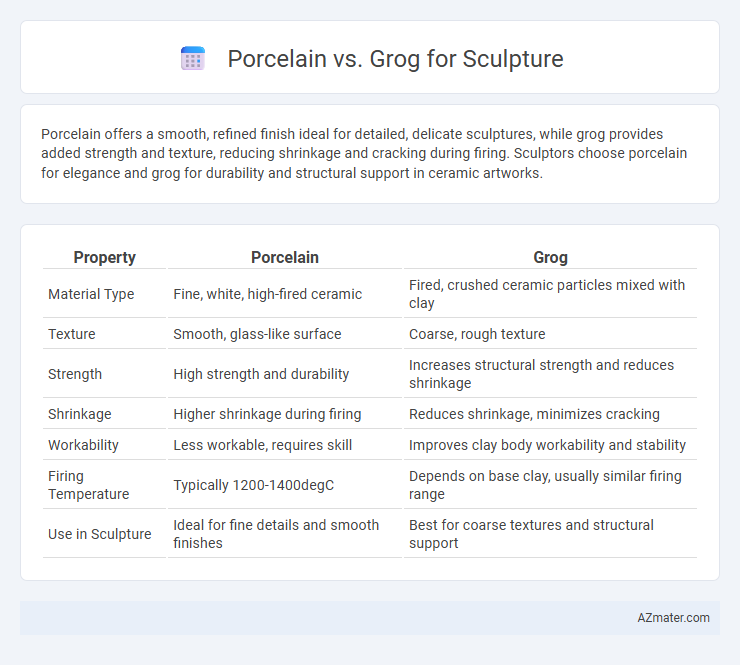Porcelain offers a smooth, refined finish ideal for detailed, delicate sculptures, while grog provides added strength and texture, reducing shrinkage and cracking during firing. Sculptors choose porcelain for elegance and grog for durability and structural support in ceramic artworks.
Table of Comparison
| Property | Porcelain | Grog |
|---|---|---|
| Material Type | Fine, white, high-fired ceramic | Fired, crushed ceramic particles mixed with clay |
| Texture | Smooth, glass-like surface | Coarse, rough texture |
| Strength | High strength and durability | Increases structural strength and reduces shrinkage |
| Shrinkage | Higher shrinkage during firing | Reduces shrinkage, minimizes cracking |
| Workability | Less workable, requires skill | Improves clay body workability and stability |
| Firing Temperature | Typically 1200-1400degC | Depends on base clay, usually similar firing range |
| Use in Sculpture | Ideal for fine details and smooth finishes | Best for coarse textures and structural support |
Introduction to Porcelain and Grog in Sculpture
Porcelain is a high-fired ceramic material known for its smooth texture, translucency, and strength, making it ideal for detailed and delicate sculptures. Grog, composed of pre-fired clay particles, is added to clay bodies to improve structural strength, reduce shrinkage, and enhance texture in sculpting processes. Understanding the differences between porcelain and grog helps sculptors select the right material for precision or durability in their ceramic artworks.
Material Composition: Porcelain vs Grog
Porcelain consists primarily of kaolin clay combined with feldspar and quartz, resulting in a smooth, fine-grained texture ideal for detailed sculpture work. Grog is composed of pre-fired, crushed ceramic material mixed into clay bodies to enhance structural strength, reduce shrinkage, and improve fire resistance. The key difference lies in porcelain's purity and translucency versus grog's coarse, granular nature used to modify clay's physical properties during sculpting.
Workability and Sculpting Techniques
Porcelain offers a smooth, fine-grained texture that allows for intricate detailing and delicate sculpting techniques, making it ideal for precision work but requiring careful handling due to its tendency to be fragile during drying and firing. Grog, composed of fired clay particles, enhances workability by improving clay's strength and reducing shrinkage, which supports more robust building methods such as slab and coil construction, and is advantageous for larger, more structural sculptures. Sculptors choose porcelain for its refined finish and grog for its durability and ease in maintaining form, balancing delicate modeling with structural integrity in their techniques.
Structural Strength and Durability
Porcelain offers a smooth, fine-grained texture with high structural strength due to its vitrification during firing, making it ideal for delicate, detailed sculptures. Grog, consisting of pre-fired clay particles, enhances durability by increasing the sculpture's resistance to thermal shock and reducing shrinkage during drying and firing. Sculptors choose grog for larger, more robust pieces requiring impact resistance, while porcelain suits intricate works demanding strength and a refined finish.
Surface Texture and Finish
Porcelain offers a smooth, fine-grained surface texture ideal for detailed, polished sculptures with a glossy finish that enhances delicate features. Grog, made from ground fired clay, provides a coarse, gritty texture that adds strength and reduces shrinkage, resulting in a rougher, matte finish well-suited for rustic or textured artistic effects. Choosing between porcelain and grog depends on the desired tactile quality and final aesthetic of the sculpture's surface.
Firing Temperatures and Shrinkage
Porcelain typically fires at higher temperatures between 1200degC and 1400degC, resulting in a vitrified, glass-like finish with minimal porosity, while grog, composed of pre-fired fired clay particles, fires at lower temperatures ranging from 800degC to 1100degC and helps reduce overall shrinkage. Porcelain's shrinkage rates are generally around 12-15%, which can lead to warping or cracking if not carefully managed, whereas grog additions lower shrinkage to approximately 4-6%, enhancing dimensional stability during drying and firing. The choice between porcelain and grog affects not only firing temperature but also thermal shock resistance and final sculpture durability.
Glazing Compatibility and Results
Porcelain offers a smooth, non-porous surface ideal for achieving glossy, vibrant glazes that enhance fine details in sculpture, while grog's rough texture can cause irregular glaze pooling and a more matte finish. Glazing porcelain requires careful firing to prevent cracking due to its low thermal expansion, whereas grog's addition improves thermal shock resistance and reduces shrinkage, allowing for more robust glaze application. Sculptors choose porcelain for precise, high-definition glazes and grog for rustic, textured effects with more forgiving firing behavior.
Suitability for Large-Scale Sculptures
Porcelain's fine texture and strength make it ideal for detailed, smaller sculptures but less suitable for large-scale works due to its brittleness and tendency to crack during firing. Grog, composed of pre-fired clay particles, enhances structural integrity and reduces shrinkage, making it the preferred choice for large-scale sculptures requiring durability and stability. Sculptors working on monumental pieces often incorporate grog to prevent warping and improve overall support throughout the drying and firing process.
Cost and Accessibility of Materials
Porcelain is often more expensive than grog due to its refined clay composition and the high firing temperatures required, increasing overall material costs for sculptors. Grog, made from ground fired clay, is more affordable and widely accessible, making it a cost-effective choice for large-scale or rough-textured sculptures. The availability of grog in various particle sizes offers artists flexibility while managing expenses, whereas porcelain's cost and limited local availability can restrict its use to specialized applications.
Choosing the Right Material for Your Sculpture
Porcelain offers a smooth, refined finish ideal for detailed, delicate sculptures, while grog enhances structural strength and texture, making it suitable for larger, more robust pieces. The choice between porcelain and grog depends on the desired durability, surface detail, and firing temperature, with porcelain typically requiring higher firing temperatures for vitrification. Sculptors seeking fine detail and translucency often prefer porcelain, whereas those prioritizing workability and reduced shrinkage opt for grog-infused clay bodies.

Infographic: Porcelain vs Grog for Sculpture
 azmater.com
azmater.com